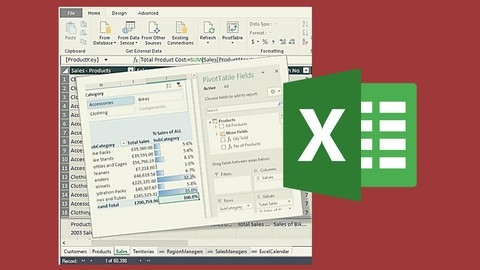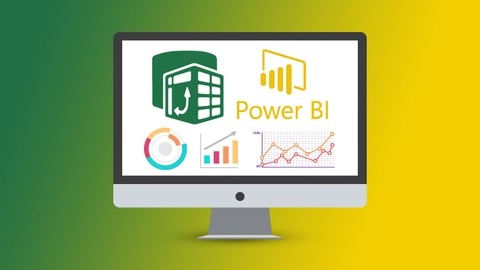Power Pivot is a powerful data analysis tool within Microsoft Excel that allows you to work with large datasets, create sophisticated data models, and perform complex calculations.
By learning Power Pivot, you can unlock the true potential of your data, uncover hidden insights, and make more informed decisions.
From building interactive dashboards to performing advanced analytics, Power Pivot equips you with the skills to become a data analysis powerhouse.
Finding a comprehensive and well-structured Power Pivot course on Udemy can be a challenge.
With numerous options available, you need a course that not only covers the fundamentals but also dives into advanced techniques and provides practical examples to solidify your understanding.
You’re looking for a course that can take you from a Power Pivot novice to a confident data analyst.
Based on our thorough analysis, we believe the Complete Introduction to Excel Power Pivot course is the best overall choice on Udemy.
This course provides a comprehensive introduction to Power Pivot, guiding you through the essentials of data modeling, DAX formulas, and data visualization.
The instructor’s clear explanations and practical exercises make learning Power Pivot both engaging and effective.
However, we understand that everyone has different learning styles and preferences.
That’s why we’ve compiled a list of other top-rated Power Pivot courses on Udemy, each with its own unique strengths and focus.
Keep reading to explore our recommendations and discover the perfect Power Pivot course to empower your data analysis journey.
Complete Introduction to Excel Power Pivot
This course guides you through the essentials of Excel Power Pivot, starting with how to activate it and load data into the Data Model.
You quickly transition from these fundamentals to practical tasks like browsing, filtering, and sorting data—crucial skills for effective data analysis.
You’ll even build your first Pivot Tables to analyze data, experimenting with different aggregation methods and using slicers to pinpoint the information you need.
You then explore Calculated Columns, powerful tools for manipulating data with formulas.
You’ll discover how to extract specific information, such as year, month, and day, from dates using these calculated columns.
The course then introduces Measures—calculations used to gain insights from your data.
You’ll master the essential “Calculate” formula and the powerful “ALL” and “ALLEXCEPT” formulas, which give you precise control over your data aggregation.
Time Intelligence, a vital skillset for analyzing data trends over time, is covered extensively.
You’ll learn how to use SUMX for complex data analysis and apply the RankX function to prioritize data, such as ranking customers based on specific criteria.
This practical approach extends to working with real-world data in case studies.
You’ll learn to create relationships between datasets, build insightful dashboards, and discover how to utilize Power Query for seamless data loading.
DAX Power Pivot - 10 Easy Steps for Beginners
You’ll start by building data models, importing external data, and learning how to manipulate it effectively.
You’ll then dive into creating pivot tables and exploring relationships between them, allowing you to gain insights from your data.
The course covers how to add Excel data to your data model, linking tables and importing entire Excel files.
The course progresses to the core of DAX, teaching you how to create calculated columns and measures.
These powerful tools enable you to perform custom calculations and complex analysis.
You’ll learn how to use them within the data model itself and within Excel.
You’ll also explore essential DAX functions like RELATED() and RELATEDTABLE(), allowing you to connect related data from different tables.
You’ll learn how to use COUNT() and DISTINCTCOUNT() to count records and unique values, along with techniques for working with date fields in calculated columns.
The course delves deeper with the CALCULATE() function, a key tool for manipulating calculations.
You’ll learn how to use it with operators like AND and OR, along with comparison operators and date functions.
Finally, you’ll explore using CALCULATE() with ALL(), enabling you to perform calculations across all records, ignoring existing filters.
DAX Power Pivot - 10 Easy Steps for Intermediates
You’ll start by mastering the fundamentals of Power Query, learning how to shape and clean your data before diving into the powerful world of DAX.
You’ll get a solid grounding in core DAX functions like CALCULATE, SUMX, and FILTER, building your ability to create impactful measures and gain valuable insights from your data.
The course progressively introduces more advanced concepts like context transitions and disconnected tables, equipping you with the tools to tackle complex data analysis challenges.
You’ll explore powerful techniques like Thresholds & Banding, enabling you to group and categorize your data for deeper understanding.
You’ll also delve into the creation of Key Performance Indicators (KPIs), allowing you to track and monitor your business objectives effectively.
The course culminates with an introduction to CUBE formulas, including CUBEVALUES, unlocking even more advanced functionalities within Power Pivot.
Master DAX fundamentals : Power BI, Power Pivot & SSAS
This course on DAX fundamentals teaches you everything you need to know to become a Power BI, Power Pivot, and SSAS master.
You will start with the basics of calculated columns and measures.
You learn how to use important DAX functions such as SUM, SUMX, Count, and CountX to get the results you need from your data.
You will also become familiar with the Currency data type and learn how to use the ROUND function.
This ensures your calculations are accurate every time.
The course then dives into important DAX expressions like DIVIDE and BLANK.
You will know how to avoid errors when dividing numbers and work with blank values to keep your data tidy.
You learn to connect and use data from different tables using RELATED and RELATEDTABLE functions.
You will become comfortable working with data from different tables.
This course teaches you to find the smallest and largest values with MIN and MAX.
IF statements will help you make decisions based on specific conditions in your data.
DAX variables and the SWITCH expression will help you perform more complex calculations.
You will discover how DAX works behind the scenes and learn to use table functions to manipulate data in powerful ways.
You will understand how to Ignore Filters when you need to work with all your data, regardless of any filters you have applied.
You will also master the Calculate function, an invaluable tool for advanced DAX calculations.
This course also covers nested row context.
This is important for understanding how DAX evaluates your formulas.
You learn to create and use date tables.
This is important for analyzing data over time.
You will use functions like Datesadd and Parallel Periods.
These tools help you compare data from different periods and see how things change over time.
You will learn about Moving Totals and Overall Totals, essential for understanding trends and patterns.
The Power Pivot, Power Query in Excel and Power BI Bundle
This course takes you on a journey from data newbie to data expert using Microsoft’s powerful tools: Power Query, Power Pivot, and Power BI.
You begin by learning how to use Power Query to clean up messy data and transform it into a usable format.
You then learn how to import this data from different places like your computer or even the web.
You’ll even discover how to combine data from multiple sources, ensuring you can work with all your data in one place.
Next, you’ll dive into Power Pivot and discover how to build relationships between different sets of data.
Think of it like connecting the dots to see the bigger picture.
You’ll learn how to use DAX, a special formula language, to create calculated columns and measures.
These calculations help you uncover hidden insights within your data.
Imagine being able to calculate the total sales for a specific product or identify trends over time – DAX makes it possible.
Finally, you’ll explore Power BI Desktop, where you’ll transform your analyzed data into interactive reports and dashboards.
You’ll learn how to build charts, maps, and graphs that bring your data to life.
You’ll also discover how to use filters and slicers to focus on specific aspects of your data and drill down to uncover deeper insights.
Once your reports are ready, you’ll learn how to publish and share them with others, allowing them to explore and interact with your findings.
Power BI & Power Pivot: Introduction
This Power BI & Power Pivot course takes you on a journey from basic pivot tables to creating impactful dashboards.
You begin by mastering Power Pivot, learning to combine data and create relationships between tables.
Imagine connecting sales data with customer information, revealing insights you couldn’t get from isolated tables.
You then learn to import data, building a robust data model that acts as the foundation for your analysis.
The course then guides you into the world of Power BI.
You discover how to import data and establish relationships between datasets, mirroring your Power Pivot expertise.
You’ll learn to build a date table, a powerful tool for analyzing trends and changes over time.
The course then unveils the art of data visualization.
You will master various charts and graphs, from simple tables and bar charts to interactive maps and eye-catching area charts.
You discover how to use slicers to filter data dynamically and cards to highlight key metrics, bringing your data to life.
Through hands-on exercises, you will transform raw data into a compelling Power BI report page.
Imagine building a dashboard that clearly shows sales trends, customer demographics, or product performance, all in one visually appealing and easy-to-understand interface.
This course equips you with the knowledge and skills to analyze data effectively and communicate your findings with impact.
Excel 2016 PowerPivot, PowerQuery, PowerView & BI
This course takes you on a journey to master Excel 2016’s powerful data analysis tools.
You begin by discovering Power Query, learning how to import, clean, and transform data from various sources like relational databases.
You also explore Microsoft Query, another valuable tool for retrieving data.
The course then guides you through Power Pivot, where you unlock the true potential of data analysis.
You delve into OLAP (Online Analytical Processing) and understand how it accelerates data analysis.
You learn the benefits of Power Pivot over traditional pivot tables and the Excel Data Model, gaining the ability to handle large datasets efficiently.
You master the art of creating relationships between tables and building insightful pivot tables within Power Pivot.
You even dive into DAX (Data Analysis Expressions) and learn to create calculated columns and measures, giving you the power to extract deeper insights from your data.
Finally, you explore Power View, where you transform your analyzed data into dynamic and interactive reports.
You master Power View’s user interface and learn to design visually appealing reports that bring your data to life.
This course equips you with the skills to analyze complex datasets, create insightful reports, and become proficient in using advanced BI tools within Excel 2016.
DAX Power Pivot Time Intelligence - 10 Easy Steps
This course guides you through mastering time-based data analysis in Power Pivot using DAX.
You begin with running totals, a fundamental concept for trend analysis, learning how to calculate year-to-date values using functions like DATESYTD().
You then explore date intervals, using functions like PREVIOUSYEAR() and DATEADD() to compare data from different periods, gaining insights from year-over-year comparisons with SAMEPERIODLASTYEAR().
You learn to pinpoint specific dates within your data using functions like FIRSTDATE(), LASTDATE(), ENDOFMONTH(), and STARTOFYEAR(), laying the groundwork for more intricate analyses.
You then move on to analyzing data within specific date ranges using DATESBETWEEN(), a valuable tool for identifying patterns and trends within specific timeframes.
You discover the power of FILTER(), learning how to create custom calculations and refine your analysis based on specific criteria.
The course then introduces you to the world of custom calendars, enabling you to work with non-standard date structures, and teaches you how to manage these custom calendars effectively within Power Pivot.
The course further enhances your skills by introducing DAX Patterns, powerful templates that streamline complex time intelligence calculations.
You learn how to recreate familiar functions like DATESYTD() using this pattern-based approach, gaining greater flexibility in your analysis.
You then tackle the challenge of suppressing and fixing totals in Power Pivot reports, ensuring accurate data presentation.
You learn to use HASONEVALUE(), MIN(), and MAX() to achieve accurate and meaningful calculations, refining the precision of your reports.
You also learn how to calculate percentage growth measures, a crucial aspect of time intelligence, enabling you to quantify trends and changes over time.
Through practical exercises, you solidify your understanding of these concepts and become proficient in applying them to real-world scenarios.
This course equips you with the tools and techniques to confidently analyze time-based data, empowering you to extract meaningful insights for better decision-making.








